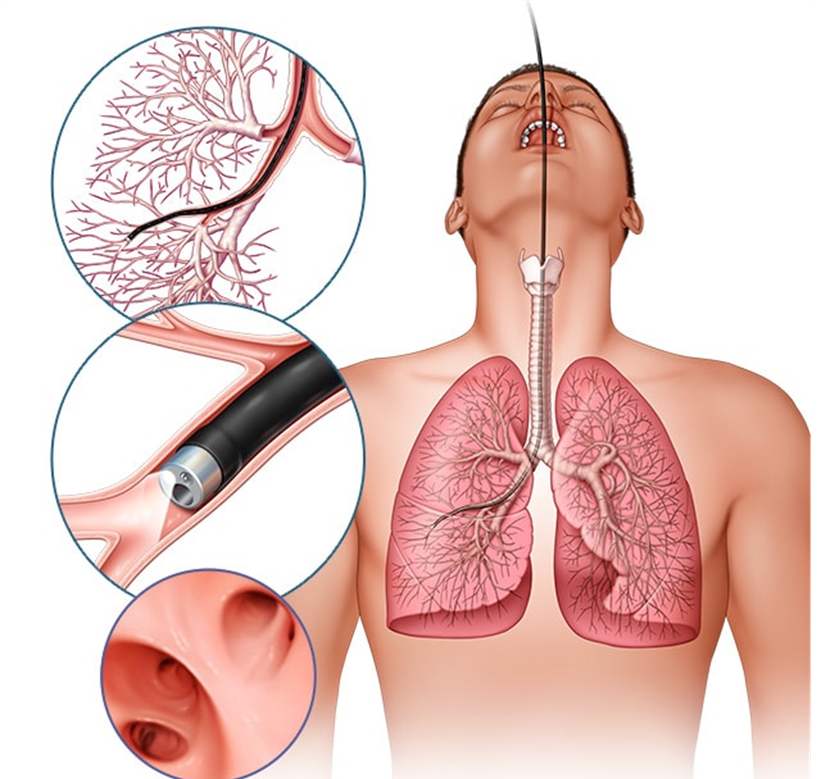A client who had a bronchoscopy 2 hours ago asks for a drink of water. What action would the nurse take initially to assure client safety?
Assess the client’s gag reflex before giving any food or water.
Provide the client with ice chips instead of a drink of water.
Contact the primary healthcare provider and get the appropriate orders.
Let the client have a small sip to evaluate the ability to swallow.
The Correct Answer is A
Choice A Reason:
Assessing the client’s gag reflex before giving any food or water is crucial after a bronchoscopy. The procedure involves the use of local anesthesia to numb the throat, which can impair the gag reflex and increase the risk of aspiration. Ensuring that the gag reflex has returned before allowing the client to eat or drink helps prevent choking and aspiration, which are serious complications.

Choice B Reason:
Providing the client with ice chips instead of a drink of water is not the best initial action. While ice chips may seem like a safer option, they still pose a risk of aspiration if the gag reflex has not fully returned. The priority is to first assess the gag reflex to ensure the client can safely swallow.
Choice C Reason:
Contacting the primary healthcare provider and getting the appropriate orders is not necessary as the first action. The nurse can independently assess the gag reflex, which is a standard nursing practice after procedures involving throat anesthesia. If there are concerns after the assessment, then contacting the healthcare provider would be appropriate.
Choice D Reason:
Letting the client have a small sip to evaluate the ability to swallow is not safe without first assessing the gag reflex. This approach could lead to aspiration if the gag reflex has not returned. The initial step should always be to assess the gag reflex to ensure the client can safely swallow liquids.
Nursing Test Bank
Naxlex Comprehensive Predictor Exams
Related Questions
Correct Answer is A
Explanation
Choice A Reason:
Activating the hospital’s emergency or rapid response system is the most appropriate first action in this scenario. The client is exhibiting signs of a potentially life-threatening condition, such as airway obstruction or severe swelling that could compromise breathing. Immediate intervention by a rapid response team can provide the necessary advanced airway management and other critical care measures to stabilize the patient. This action prioritizes the client’s airway, breathing, and circulation, which are the fundamental aspects of emergency care.
Choice B Reason:
Placing a heart monitor on the client and observing for dysrhythmias is important but not the immediate priority in this situation. While monitoring the heart is crucial, the client’s airway and breathing issues take precedence. Addressing the airway obstruction and ensuring adequate breathing should be the first step before focusing on cardiac monitoring.
Choice C Reason:
Asking the charge nurse to come see the client immediately is a reasonable action, but it may delay the necessary urgent intervention. The charge nurse may not have the advanced skills or equipment required to manage a severe airway obstruction. Activating the rapid response system ensures that a team of healthcare professionals with the appropriate expertise and equipment can respond quickly.
Choice D Reason:
Checking the client’s blood pressure and heart rate is a standard nursing assessment, but it is not the immediate priority in this emergency situation. The client’s difficulty breathing and stridor indicate a potential airway obstruction, which requires immediate attention. Ensuring the airway is clear and the client can breathe is more critical than checking vital signs at this moment.
Choice E Reason:
Providing a calm and assuring environment for the client is important for reducing anxiety and stress, but it does not address the immediate life-threatening issue. While maintaining a calm environment is beneficial, the nurse must first ensure that the client’s airway is secure and that they can breathe adequately. This can only be achieved by activating the rapid response system.
Correct Answer is ["31"]
Explanation
Let’s calculate the IV infusion rate step by step.
Step 1: Determine the total volume to be infused.
The total volume ordered is 1,000 mL.
Step 2: Determine the total time for the infusion.
The total time is 8 hours.
Step 3: Calculate the infusion rate in mL per hour.
Total volume (1,000 mL) ÷ Total time (8 hours) = 125 mL per hour.
Result: 125
Step 4: Determine the drop factor.
The IV tubing delivers 15 drops per milliliter.
Step 5: Calculate the infusion rate in drops per minute.
Infusion rate (125 mL per hour) × Drop factor (15 drops per mL) = 1,875 drops per hour.
Result: 1,875
Step 6: Convert the infusion rate to drops per minute.
Total drops per hour (1,875 drops) ÷ 60 minutes = 31.25 drops per minute.
Result: 31.25
Step 7: Round the result to the nearest whole number if necessary.
31.25 rounded to the nearest whole number is 31.
The nurse should run the IV infusion at a rate of 31 drops per minute.
Whether you are a student looking to ace your exams or a practicing nurse seeking to enhance your expertise , our nursing education contents will empower you with the confidence and competence to make a difference in the lives of patients and become a respected leader in the healthcare field.
Visit Naxlex, invest in your future and unlock endless possibilities with our unparalleled nursing education contents today
Report Wrong Answer on the Current Question
Do you disagree with the answer? If yes, what is your expected answer? Explain.
Kindly be descriptive with the issue you are facing.
